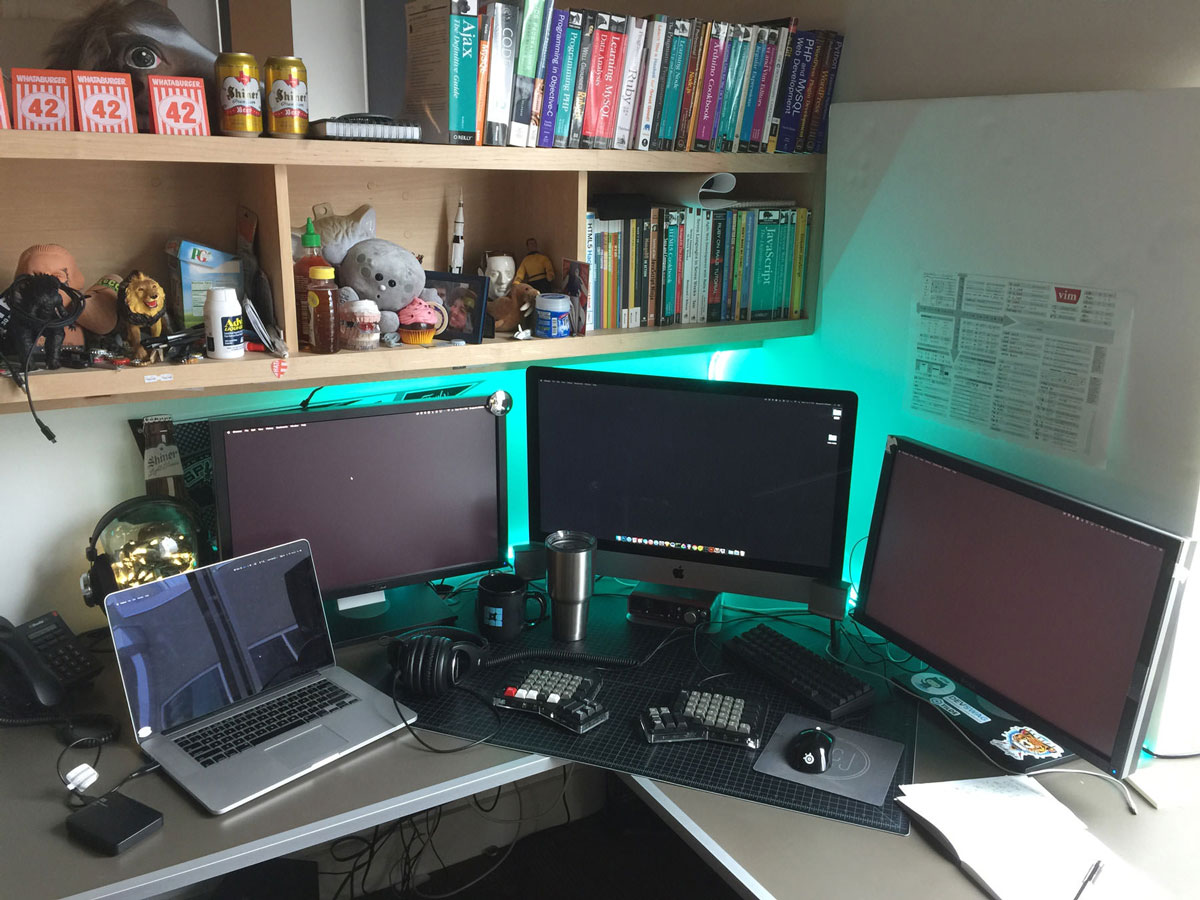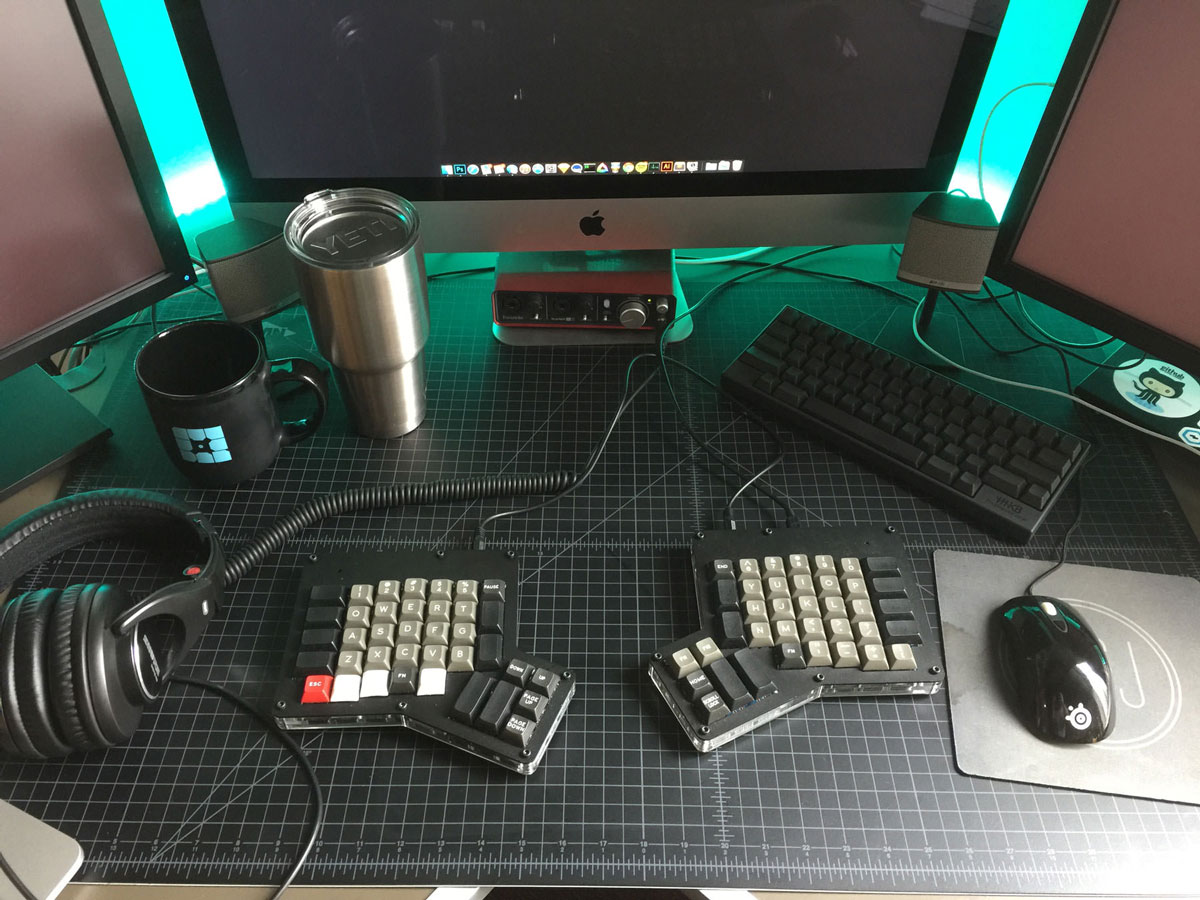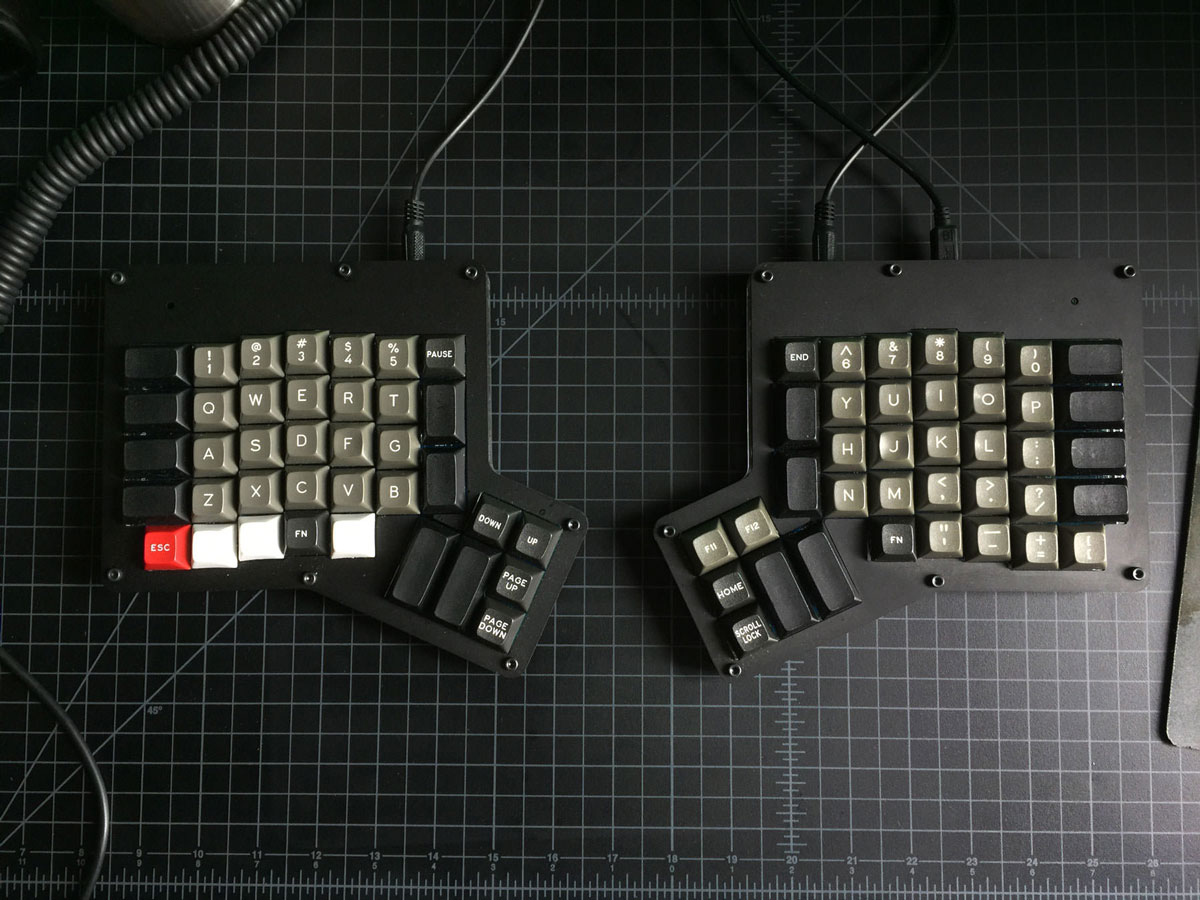Benjamin Mikiten’s Mac setup
Every week we post a new interview with someone about what software they use on their Mac, iPhone, or iPad. We do these interviews because not only are they fun, but a glimpse into what tools someone uses and how they use those tools can spark our imagination and give us an idea or insight into how we can do things better.
New setup interviews are posted every Monday; follow us on RSS or Twitter to stay up to date.
Who am I and what do I do?
I’m a developer for McGarrah Jessee, an Austin advertising agency with some really cool clients. I’m part of a very small three person team that handles all the front- and back-end development for digital projects that come through here. I went to school to be a graphic designer, but switched teams my senior year. Because of this, I’m able to pick up a lot of digital production work as well, which means a lot of hopping between designing and coding.
What is your current setup?

I’m on a 2012 24″ iMac flanked by two Dell 24″ UltraSharp displays. The other developer and I are in a cold war of adding monitors. Because I added the iMac recently and haven’t had time to migrate absolutely everything, I usually have at least one laptop open next to me for a total of four screens (13,478,400 total pixels!) at any given time.
The coolest thing about my setup is my keyboards. I swap between two — a HHKB Pro 2 or a custom-built Ergodox, depending on how nerdy I’m feeling. I started getting obsessed with mechanical keyboards about two years ago, and finally put a stop to the addiction with the HHKB, a wedding present from my brother. Mechanicals provide a better tactile feedback than traditional rubber-dome keyboards and make a really satisfying sound while you type. Since I very literally have my hands on this thing the whole time I’m at work, I thought it made sense to put some thought into what keyboard I used.

The Ergodox is an open-sourced DIY ergonomic keyboard kit you can get from Massdrop periodically. It’s a split-hand design meaning you can have your hands further apart and your wrists at a better angle. The thumb clusters also put your very-flexible thumbs to better use than just whacking a spacebar all the time. It’s a daunting project and requires some soldering skills (surface-mount diodes abound!), but it fosters a “there are many like it, but this one is mine” kind of pride in a developer’s most essential tool. The HHKB is a 60% keyboard (no numpad, and you access the arrow keys by holding down a function key and using ], ;, ', and /), which gives me more room on my desk and less distance for my right hand to travel to my mouse. It uses Topre switches (the Ergodox and most other mechanicals use Cherry MX switches), which have a very specific ‘thocky’ feel that nothing else quite mimics.

I have a cutting mat on my desk, inspired by this Gear Patrol post, which cleans easily and works as a great mousepad. I also have a strip of arduino-controllable RGB LED lighting behind my desk and a glass head full of twinkling Christmas lights because, you know. The shelves above my desk house my library of code books (they give me a +10 developer-looks-smart bonus), and piles of nerdy knick-knacks, a perk of working at a place with a fun culture.
What software do you use and for what do you use it?
I hop between Photoshop CC, Sublime Text 3, iTerm2, Chrome DevTools, and Mail pretty regularly. My job usually requires gettings loads of PSDs from designers, cleaning up the files, exporting assets, and then building out a site from them.
I could write (and they have been written) a massive tome about the software I use for development, but since there’s a new hot post about the modern front-end developer’s stack every week, I’ll leave it to others to go into depth.
Most of my time is spent in Sublime Text 3, hands down my favorite all-around text editor for coding. I love it for the rich community of super useful plugins, and with some careful time spent choosing plugins, you can custom-build as rich an IDE as the webdev community can expect for a while.
I use iTerm2 as my terminal, and it seems like the majority of the other tools I use are at the command line. Compared to the productivity world, the app landscape for developers is composed mostly of lots of little command line tools that you customize yourself and build for specific tasks. Two hot programs like that that I use often are gulp and grunt, JavaScript-based ‘task runners’ that take care of things like converting files over, combining templates, and hosting servers for local testing.
One of the neat things I use that stands out is vim: a mouse-less, command-line based text editor. It has a famously daunting learning curve, and watching a pro use it makes it seem like they’re controlling the cursor with their mind rather than key commands. I sometimes feel brave enough to use it right in the terminal, and sometimes I fall back to MacVim, but I always use Vintageous inside Sublime Text. The learning curve truly is vertical (one day it just clicks), but the longer and more consistently you use it, the more it makes sense — and it really is that fast.
I also have to give a shout-out to ImageOptim and Jpeg Mini, probably my two most-used apps that aren’t listed above. It’s the perfect one-two punch for image assets, and I use them constantly. Jpeg Mini has an awesome up-to-the-limit lossy compression algorithm, and ImageOptim does some serious magic losslessly stripping other info out of jpegs, gifs, and pngs. If you make websites, these two tools are ESSENTIAL to crunch down your assets to the absolute smallest they can be.
I use Yet Another Dotfile Repo for system, terminal, and vim settings (things like .bashrc, .vimrc — dotfiles) and plugins because I appreciate when someone has opinions and doesn’t care whether they’re wrong. Also, I’m too trusting with shell access, but mostly I installed these settings long ago and just got used to them. It’s a great package of plugins for vim, and it goes a long way to make your terminal experience as vim-y as possible, as well as some other very handy tweaks to vanilla OS X that are nice for development.
I’m plain-text as much as possible. I don’t want to leave ST3 or vim if I don’t have to, so I have an IFTTT rule that saves .txt and .md files saved to a specific Dropbox folder to Evernote, and even a slick ST3 add-on that lets me write markdown and save it to Evernote. I also use Adobe’s Source Code Pro font wherever I’m writing, and I use Solarized Dark wherever it’s supported.
On the traditional productivity end of the spectrum, I use Todoist (because it integrates with IFTTT), or my MUJI notebook to keep track of what I need to do. I abuse Pinboard to track and remember basically any website I come across that I have the vaugest possibility of wanting to remember. Even though Spotlight is looking similar to it, I’m sticking with Alfred. My menu bar is chock-full of little apps — iStat for network and CPU meters, TextExpander for all of my commonly-typed phrases (lots of client website URLs), Characters for quick special characters, and Sip for grabbing colors.
How would your ideal setup look and function?
I’m getting very close to my perfect setup. When I had fewer monitors and a retina Macbook Pro, I rocked the $22 IKEA standing desk with great success. I’d really like to find a way to raise this thing up, but I think it would involve a suspension bridge.
When I got the Ergodox, I had this dream of somehow attaching them to the arms of my chair so I could lean back and code in some sort of mission-control captain’s-chair thing. That’s a slippery slope I don’t plan on heading down because it ends in a motorized dev-command battle chair, and me gaining 300 pounds because I never have to get up anymore.
All of this aside, I wanted to work at McJ when I was in high school, and this is absolutely my dream job. I was lucky enough to get this right out of college, and even if my setup was a mop and bucket, I’d be content.
There are more Sweet Setup interviews right here.
